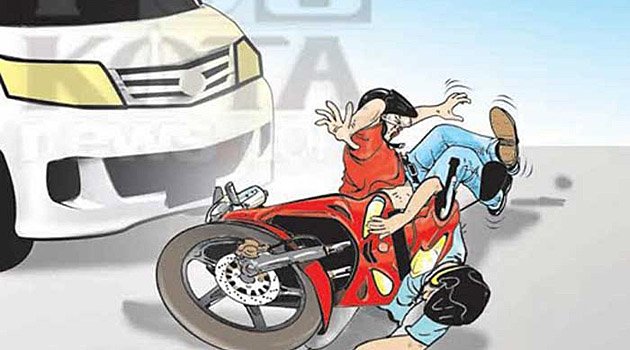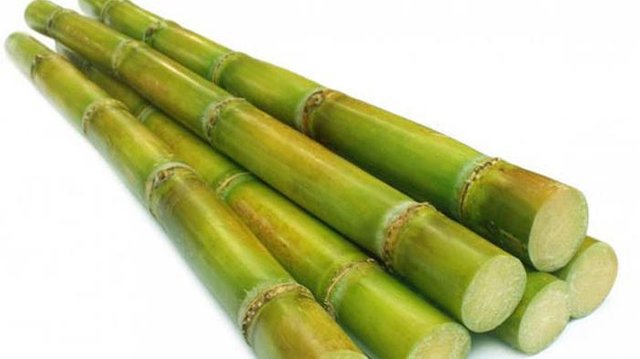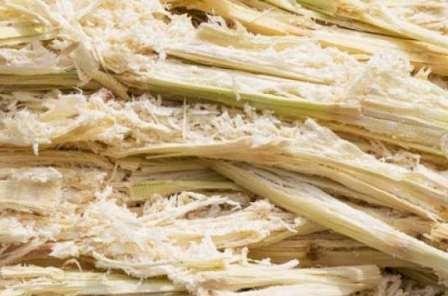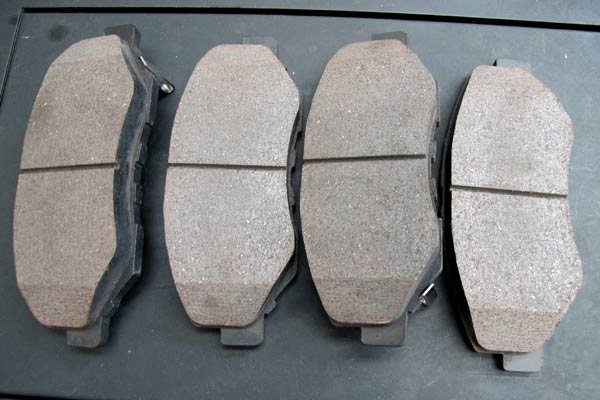Utilizating Bagasse In The Manufacture of Non Asbestos Brake Pads - Fiber Based
Hi all steemit friends, In this opportunity, I discuss how to use bagasse for the process of brake lining making. My reason, Why I discussing this? because brake lining is a vehicle product that is so important and vital. Congestion or damage to brake lining can lead to accidents and even death. Now with a touch of modern technology, humans are able to process bagasse into a vital and important product for motor vehicles.
Indonesia became the 3rd country with the largest motorcycle population in Asia due to vehicle absorption rate . The huge growth rate of motor vehicle sales in Indonesia has had a positive impact on the automotive industry.
Deputy Transport Minister Bambang Susantono, in the discussion 'Mudik Survivor, Reduced Petaka Highway', held Independent Bikers Club, in collaboration with the Ministry of Transportation, Astra Honda Motor, and Road Safety Association , he said:
In 2010 there were approximately 455 million motorcycles used worldwide, or about 69 motorcycles per 1,000 residents. While the car is only about 782 million cars in the world or about 118 per 1,000 residents.[Source]
Traffic accidents in Indonesia in 2011,72% involving motorcycles. The data shows that the cause of traffic accidents involves more motorcycles.
Traffic accidents involving motorcycles often occur due to broken brake lining or brake jams. Today, brake pads sold in the market are quite expensive, so to overcome them with a touch of innovative advanced technology, brake pads can be processed by using bagasse. Maybe before the technological's era of bagasse only became waste and factory waste. Therefore, rather than wasted and become garbage, the bagasse can be used for brake pads making, so brake lining made from bagasse can be sold at a more economical price.
Beside, the use of asbestos materials for the manufacture of brake linings has been banned because asbestos can cause disease for workers and users. And according to International reports already 55 countries outlaw the total use of Asbestos. Thus, bagasse can be an alternative solution to produce vital and important motor vehicle supporting products.
Utilizating Bagasse In The Manufacture of Non Asbestos Brake Pads - Fiber Based
1) Definition of Sugarcane and Its Usefulness
Sugarcane is a plant that planted for raw materials of sugar and vetsin.From the process of making sugarcane produces sugar 5%, bagasse 90%, and the rest are molasses and water. Not only is the water useful, but dried cane leaves contain very high calorie values. Therefore, dry cane leaves are often used as fuel for cooking. Cooking using dried sugarcane leaves can save kerosene which today is very expensive price.
Apparently quite a lot of benefits from sugar cane, ranging from water, dregs, and leaves. In the present era with a variety of advanced technology is very possible to be processed into other products that are beneficial to humans, such as boiler fuel, motorcycle brake pads, and the steam can be used to run the turbine to activate the generator at the power plant. [Source]
2) Definition of Bagasse and Its Usefulness
The bagasse is defined as a fibrous substance from the sugar cane or sorghum process after stalks are crushed to extract their juice. That's the residue of the sugar cane process after being extracted in the sugar refining industry known as a fibrous waste product.
Now, bagasse can be used for human life. The bagging of the bagasse can be said to be a process where the bagasse is no longer a waste and a prewar waste that was once just wasted in vain. processing bagasse into something useful and can be used for human purposes in life can not be separated from the influence of globalization and advancement in the field of science and innovative technology.
3) Milling and Extraction Process
Per stem of sugarcane, to produce the pulp of the milling process carried out as much as 5 (five) times. The first and second grinding is done to produce raw brown yellow water, then in the third mill until the fifth grinding process to produce the sap with different volume. From the first and second grinding process the wet wet pellets of the initial milling process are first and secon d mill are produced wet wet bagasse. In the second mill rolling pulp mill process in order to produce optimal sap, it is necessary to add lime 3Be milk, even in the third milling nira can still be absorbed even though the volume is not the same as the second grinding result, so on the milling so on until the fifth mill if added lime 3Be milk can still produce sap with varying volume depending on the amount of juice obtained. Source
4) Definition of Brake
Brake is a device that serves to slow or stop the wheel movement. When wheel motion is slowed due to the braking, the vehicle automatically becomes slower. [Source]
Brake can also be interpreted as an apparatus by using an artificial frictional resistance applied to something that rotates like a wheel of a vehicle in order for its rotational motion to stop. The brakes absorb lost kinetic energy from moving parts or objects. Usually the kinetic energy absorbed by the brakes is converted into a form of heat. [Source]
So, from the above understanding can be understood that the brakes have two senses. First, the brakes can be interpreted as a device that can be used to move or stop body movement. Second, the brake is a friction device to converting the kinetic energy of the vehicle's heat movement by using friction.
5) How The Process of Making Friction Material For Brake Pads?
In the process of making the brake pad, in the friction material there are constituents which generally consist of fibers, binders and fillers. Fiber function to improve the coefficient of friction and strength of mechanical materials. Fiber is divided into two types, namely artificial and natural fibers. The artificial fibers used are nylon and glass fiber. While natural fibers such as coconut fiber, bamboo, hemp and jut are used as reinforcement.
6) Brake Design Capacity
There are several factors that determine the capacity or design of a brake. These factors are as follows:
1). The pressure factor between the brake plane
2). The coefficient of friction between the brake plane
3). The peripheral speed of the brake drum, and
4). Area of ??friction surface projection. [Source]
7) Bagasse As Fber In Friction Material Making
The bagasse as a heterogeneous material containing about 30-40 percent of the "pith" fibers derived from the plant core, especially the parenchymal materials, and the "deer", "leather" or "stem" fibers, and mostly derived from sclerenchyma.
As has been pointed out above, that one of the substances arranged in the friction material is a fiber that serves to improve the coefficient of friction and the strength of mechanical materials. while bagasse contains about 30-40% of the fiber. The quantity of wet-bagasse production is nearly 3 (three) tons of per 10 tons of sugar cane extraction process. For each quantity the dregs are different depending on the amount of sugarcane produced.
Thus, Bagasse with a very large fiber content, it's very possible to be utilized to manufacture fiber-based brake products (non asbestos) as a substitute for asbestos- based brake pads.
In the process of making the fiber-based campus, the quality of brake lining must meet the standards. The standard depends on its violence and its wearability. Hardness and wear of this brake lining is very closely intertwined with the age of brake lining, drum or disk life and vehicle type. Brake lining is a composite material, so an important and vital important factor is the fibers and matrix of constituents.
According to a study ever conducted by a researcher to determine the composition of bagasse so as to produce a product of brake lining with optimal quality. In this study be done experiments on factors that affect brake linings and wear and tear determine the level of these factors.
The use of Bagasse (Fiber-Based Brake Pads) is a substitute for asbetos-based brake pads, with fillers of barite, charcoal and polyester resin. Making brake lining with pressure 100 kgm for 1 hour, then dioven for 2 hours with temperature level 120 ° C. The matrix used is polyester which is the most used resin in industries because of its advantages compared to other resin. Then performed a feasibility test with Rockwell stone test, wear test. The best quality brake liner based on the word is 35% bagasse with hardness value (72,67 ± 3,39) HRB and wear (5,74 ± 0,52) x10-4 mm2 / kg. [Source]
Conclusions
Based on the description and description above, can be taken some essence, including:
Brakes are a vital and important product on a motorcycle that has the function of slowing or stopping a motorcycle and is an apparatus that relies on artificial friction resistance applied to the wheel of a vehicle to control the rotation of the wheel.
Bagasse is very good to be used in the manufacture of brake pads because it contains a lot of fiber and easy to obtain from waste parik sugar. And fiber bagasse become the main ingredient and important in making friction material.
The best quality of brake pads based on research and expriment that has been done is bagasse 35% with hardness value (72,67 ± 3,39) HRB and wear (5,74 ± 0,52) x10-4 mm2 / kg.
Utilization of bagasse for making friction material in the process of making fiber-based brake pads is still very little.
Suggestion
For countries that produce large quantities of bagasse should be able to process the dregs into something more valuable like brake pads.
References:
[9]. dafitteknik.blogspot.co.id
[11]. etd.repository.ugm.ac.id

TRANSLATE
Halo sabahat steemit, Dalam kesempatan ini, Saya membahas bagaimana memanfaatkan ampas tebu untuk proses pembuatan kampas rem. Alasan saya membahas hal ini, karena kampas rem merupakan produk kendaraan yang begitu penting dan vital. Kemacetan atau kerusakan kampas rem bisa mengakibatkan kecelakaan bahkan kematian. Kini dengan sentuhan teknologi modern, manusia sudah mampu mengolah dan memproses ampas tebu menjadi produk yang vital dan penting bagi kendaran bermotor.

Indonesia menjadi negara ke-3 dengan populasi sepeda motor terbesar di Asia karena tingkat penyerapan kendaraan. Tingkat pertumbuhan penjualan kendaraan bermotor yang besar di Indonesia berdampak positif pada industri otomotif.
Wakil Menteri Transportasi, Bambang Susantono, dalam diskusi 'Mudik Survivor, Reduced Petaka Highway', mengadakan Independent Bikers Club, bekerja sama dengan Kementerian Perhubungan, Astra Honda Motor, dan Road Safety Association, ia mengatakan:
Di 2010 terdapat sekitar 455 juta sepeda motor digunakan di seluruh dunia, atau sekitar 69 sepeda motor per 1.000 penduduk. Sedangkan mobil hanya terdapat sekitar 782 juta mobil di dunia atau sekitar 118 per 1.000 penduduk. [Source]
Kecelakaan lalu lintas di Indonesia pada 2011,72% melibatkan sepeda motor. Data ini menunjukkan bahwa penyebab kecelakaan lalu lintas lebih banyak melibatkan sepeda motor.
Kecelakaan lalu lintas yang melibat sepeda motor sering terjadi akibat kampas rem blog atau rem macet. Dewasa ini, kampas rem yang dijual dipasar harganya lumayan mahal, maka untuk mengatasi hal tersebut dengan sentuhan teknologi canggih yang inovatif kampas rem sudah bisa diproses dengan memanfaatkan ampas tebu. Mungkin sebelum era teknologi ampas tebu hanya menjadi sampah dan limbah pabrik. Maka oleh karena itu, daripada terbuang dan menjadi sampah ada baik ampas tebu itu dimanfaatkan untuk proses pembuatan kampas rem, sehingga kampas rem yang terbuat dari ampas tebu bisa dijual dengan harga yang lebih ekonomis.
Selain itu, penggunaan bahan asbes untuk pembuatan pelapis rem telah dilarang karena asbes dapat menyebabkan penyakit bagi pekerja dan pengguna. Dan menurut laporan Internasional sudah 55 negara melarang penggunaan Asbes secara total. Dengan demikian, ampas tebu bisa menjadi solusi alternatif untuk menghasilkan produk pendukung kendaraan vital dan penting.
Memanfaatkan Ampas Tebu Dalam Pembuatan Kampas Rem Non Asbestos - Berbasis Serat
1) Tebu dan Kegunaannya
Tebu adalah tanaman yang ditanam untuk bahan baku gula dan vetsin. Dari proses produksi tebu menghasilkan gula 5%, ampas tebu 90%, dan sisanya adalah tetes dan air. Bukan hanya airnya saja yang berguna, tapi daun tebu kering juga mengandung nilai kalori yang sangat tinggi. Oleh karena itu, daun tebu kering sering digunakan sebagai bahan bakar untuk memasak. Memasak menggunakan daun tebu kering bisa menghemat minyak tanah yang saat ini harganya sangat mahal.
Ternyata cukup banyak manfaat dari tebu, mulai dari air, ampas, dan dedaunan. Di era sekarang ini dengan berbagai teknologi canggih sangat memungkinkan untuk diolah menjadi produk lain yang bermanfaat bagi manusia, seperti bahan bakar boiler, bantalan rem sepeda motor, dan uapnya bisa digunakan untuk menjalankan turbin untuk mengaktifkan generator pada pembangkit listrik. [Source]
2) Definisi Ampas Tebu dan Kegunaannya
Ampas tebu didefinisikan sebagaizat berserat dari proses tebu atau sorgum setelah tangkai dilumatkan untuk mengekstrak jusnya. Itu adalah sisa dari proses tebu setelah diekstraksi di industri penyulingan gula yang dikenal sebagai produk limbah berserat.
Kini, ampas tebu bisa dimanfaatkan untuk kehidupan manusia. Pemantaan ampas tebu itu bisa dikatakan suatu proses dimana ampas tebu tidak lagi menjadi sampah dan limbah prabrik yang dulunya hanya terbuang dengan sia-sia. pengolahan ampas tebu menjadi sesuatu yang bermanfaat dan dapat digunakan untuk keperluan manusia dalam kehidupannya tidak lepas dari pengaruh globalisasi dan kemajuan dibidang ilmu pengetahuan dan teknologi inovatif.
3) Proses Penggilingan dan Ekstrasi
Per batang tebu, untuk menghasilkan ampas melalui proses penggilingan dilakukan sebanyak 5 (lima) kali. Penggilingan pertama dan kedua dilakukan untuk dihasilkan air nira mentah yang berwarna kuning kecoklatan, kemudian pada penggilingan ketiga hingga proses penggilingan kelima untuk dihasilkan nira dengan volume yang berbeda. Dari proses penggilingan pertama dan kedua dihasilkan ampas basah proses penggilingan awal yaitu penggilingan pertama dan kedua dihasilkan ampas tebu basah. Pada proses penggilingan ampas hasil gilingan kedua agar menghasilkan nira yang optimal, maka perlu ditambahkan susu kapur 3Be, bahkan pada penggilingan ketiga pun nira masih dapat diserap meskipun volumenya tidak sama dengan hasil gilingan kedua, sehingga pada penggilingan seterusnya hingga penggilingan kelima jika ditambahkan susu kapur 3Be masih dapat menghasilkan nira dengan volume yang berbeda-beda tergantung sedikit banyaknya nira yang didapatkan. Source
4) Definisi Rem
Rem adalah suatu peranti yang berfungsi untuk memperlambat atau menghentikan gerakan roda. Ketika gerak putar roda diperlambat yang disebabkan pengreman, maka secara otomotis laju kendaraan menjadi lambat. Source
Rem juga dapat diartikan sebagai sebuah peralatan dengan menggunakan tahanan gesek buatan yang diterapkan pada sesuatu yang berputar seperti roda kendaran agar gerakan putarannya berhenti. Rem menyerap energi kinetik yang hilang dari bagian atau benda yang bergerak. Biasanya energi kinetik yang diserap oleh rem diubah menjadi bentuk panas. Source
Dari pengertian diatas dapat diphami bahwa rem memiliki dua pengertia. Pertama, rem dapat diartikan sebagai suatu alat yang bisa digunakan untuk memindahkan atau menghentikan gerakan tubuh. Kedua,
rem merupakan suatu perangkat gesekan untuk mengubah energi kinetik dari pergerakan panas kendaraan dengan menggunakan gesekan.
5) Bagaimana Proses Pembuatan Bahan Friksi Kampas Rem?
Dalam proses pembuatan kampas Rem, didalam bahan friksi terdapat zat penyusun yang pada umumnya terdiri atas serat, bahan pengikat dan bahan pengisi. Fungsi serat untuk meningkatkan koefisien gesek dan kekuatan bahan mekanik. Serat terbagi kedalam dua jenis, yaitu serat buatan dan alami. Serat buatan yang disering digunakan adalah nilon dan serat gelas. Sedangkan serat alami seperti serat tumbuhan kelapa, bambu, rami dan jut digunakan sebagai penguat.
6) Kapasitas Desain Rem
Terdapat beberapa faktor yang menjadi penentu terhadap Kapasitas atau desain dari sebuah rem. Faktor-faktor tersebut adalah sebagai berikut:
- Faktor tekanan antara bidang rem
- Koefisien gesek antara bidang rem
- Kecepatan keliling dari teromol rem, dan
- Luas proyeksi permukaan gesek. [Source]
7) Ampas Tebu Sebagai Serat Dalam Pembuatan Material Friksi
Ampas tebu sebagai bahan heterogen yang mengandung sekitar 30-40 persen serat "empulur" yang berasal dari inti tanaman, terutama bahan parenkim, dan serat "rusa", "kulit", atau "batang", dan sebagian besar berasal dari bahan sklerenchyma.
Sebagaimana yang telah dikemukan ditatas, bahwa salah satu zat yang tersusun dalam bahan friksi adalah serat yang berfungsi meningkatkan koefisien gesek dan kekuatan bahan mekanik. Sementara ampas tebu mengadung sekitar 30-40 % serat. Kuantitas produksi ampas tebu basah hampir 3 ton dari proses ekstrasi tebu per 10 ton. Untuk masing-masing kuantitas ampas yang dihasilkan berbeda tergantung pada jumlah tebu yang dihasilkan.
Dengan demikian, Bagasse dengan kandungan serat yang besar sangat dimungkinkan untuk dimanfaatkan menjadi produk kampas rem berbasis serat (kampas rem non asbestos) sebagai pengganti kampas rem berbahan asbestos.
Pada proses pembuatan kampas berbasis serat, maka kualitas kampas rem harus memenuhi standar. Standar tersebut tergantung pada kekerasan dan keausannyanya. Kekerasan dan keausan kampas rem tersebut sangat erat kaitannya dengan umur kampas rem, umur drum atau piringan dan jenis kendaraan. Kampas rem merupakan material komposit, sehingga faktor utama yang penting dan vital adalah serat dan matrik bahan penyusun.
Menurut sebuah penelitian yang pernah dilakukan oleh penliti yang bertujuan untuk menentukan komposisi bagasse sehingga diperoleh produk kampas rem dengan kualitas yang optimal. Dalam penelitian tersebut dilakukan eksperimen terhadap faktor-faktor yang mempengaruhi nilai kekerasan dan keausan kampas rem dan menentukan level dari faktor-faktor tersebut.
Penggunaan Bagasse (Kampas Rem Berbasi serat) sebagai pengganti kampas berbahan asbes, dengan bahan pengisi yaitu barite, arang dan polyester resin. Pembuatan kampas rem dengan tekanan beban 100 kgm selama 1 jam, kemudian dioven selama 2 jam dengan tingkat temperatur 120 °C. Sedang matrik yang digunakan adalah polyester yang merupakan resin yang paling banyak digunakan di industri-industri karena kelebihannya dibandingkan resin yang lain. Kemudian dilakukan Pengujian kelayakan dengan uji kekerasan Rockwell, uji keausan metode Ogoshi dan pengambilan foto mikro sample produk. Kualitas kampas rem terbaik berdasarkan penelitian tersebut adalah bagasse 35% dengan nilai kekerasan (72,67±3,39) HRB dan keausan sebesar (5,74±0,52)x10-4 mm2/kg [Source].
Kesimpulan
Berdasarkan uraian dan deskripsi diatas, dapat diambil beberapa inti sari, diantaranya adalah:
Rem merupakan produk vital dan penting pada sepeda motor yang memiliki fungsi untuk memperlambat atau menghentikan sepeda motor dan merupakan sebuah peralatan yang mengandalkan tahanan friksi buatan yang diterapkan pada roda kendaran untuk mengendalikan gerakan putaran roda.
Ampas Tebu sangat bagus untuk dimanfaatkan pada pembuatan kampas Rem karena mengandung serat yang banyak dan mudah untuk didapatkan dari limbah parik gula. Dan serat ampas tebu mer<upakan bahan utama dan penting dalam pembuatan bahan friksi.
Kualitas kampas rem terbaik berdasarkan penelitian dan eksprimen yang telah dilakukan adalah bagasse 35% dengan nilai kekerasan (72,67±3,39) HRB dan keausan sebesar (5,74±0,52)x10-4 mm2/kg.
Pemanfaatan ampas tebu (bagasse) untuk pembuatan bahan friksi dalam proses pembuatan kampas rem berbasis serat masih sangat sedikit.
Saran
Bagi negara-negara yang menghasilkan ampas tebu dalam jumlah yang besar seharusnya memanfaat ampas tebu untuk dapat mengolah ampas tersebut menjadi sesuatu yang bernilai lebih seperti kampas rem.
References:
[9]. dafitteknik.blogspot.co.id
[11]. etd.repository.ugm.ac.id








@azirgraff Sounds like you have an entrepreneurial journey ahead of you. I think people could really buy into ecological brake pads!
Thanks @ashleypeat, That's my dream and I'll try someday.
Indonesia sebagai penghasil tebu lumayan banyak seharusnya bisa mengembangkan sesuai saran kawan @azirgraff, semoga saja ada pihak memberanikan diri untuk menginvestasikan hal tersebut diatas
Thanks @teukukhaidir.
It is true, the government should be able to use sugar cane waste into something valuable and bagasse not only for that, bro. but there is thing much that can be processed from bagasse into value-added products such as the steam can be used to run turbines and generators.
hi @azirgraff thank you for sharing your knowledge of good knowledge, as far as my knowledge this time I know about the benefits of sugar cane fiber. your post is very useful for other steemit users.
Hi @maskur2840, welcome to my post, thanks very much for your comment
Hi @azirgraff, thanks for your post about the benefits of sugar cane fiber, I recently mengerahui the benefits of sugar cane fiber raw material for brake motors, raw materials are very accessible in aceh.
Thanks @armiden
Sangat bermanfaat bagi steemians dunia dan khususnya steemians Indoensia. Karena Indonesia adalah negara penghasil tebu terbesar di dunia setelah Brazil, India, China, Thailand, Pakistan, Mexico, dan Colombia.
Thanks for your comments @mushthafakamal, 👍.
Many of us do not use sugarcane fiber, but only the water we take
Woow @azirgraff nice information, i like that. Graciass for you. 👍👍👍👏👏👏
Thanks @fachrulreza, but what do you like?
yes @azirgraff of course I'm very happy with the information you share. I just found out that sugar cane fiber is used as raw material sparepart vehicle that we have been using.
Nice information 👍👍
Thanks @fachrulreza
Your welcome @azirgraff 👍👌
Nice post
Yes @bossundono, what is a good thing
sungguh sangat luar biasa @azirgraff, postingan mu sangat bermanfaat bagi kami...
@thanks @abdulbarry
saya suka artikel yang menambah wawasan seperti ini. terus berkarya bro
Thanks @irza
Harusnya pemerintah mencari investor luar untuk berinvistasi di indonesia @azirgraff
Tanks @hattaarshavin, I also think so